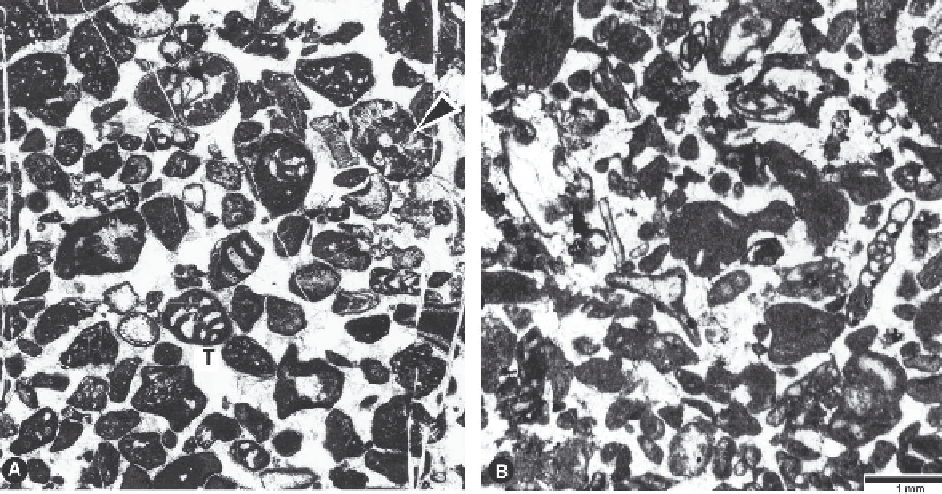Geology Reference
In-Depth Information
Fig. 14.28.
SMF Types assist in recognizing facies belts independently of the age of the rocks.
Note the amazing similarity in
grain composition and depositional texture of the two samples from Jurassic and Cretaceous limestones. Both samples
represent SMF 17, characteristic for sediments formed in platform interior environments when water depth has remained
relatively constant (late highstand phase). The similarity includes not only the grainstone texture and the dominance of
aggregate grains but also the occurrence of benthic foraminifera and algae, indicating very shallow warm-water sedimentation.
A:
Thick-bedded limestone within a subtidal shallowing-upward sequence.
Foraminifera are textulariids and
Trocholina
(T).
Green algae are represented by fragments of
Clypeina
(arrow).
Late Jurassic: Sulzfluh, Graubünden, Switzerland.
B:
Thin-bedded lagoonal limestone at the base of a mixed siliciclastic-carbonate sequence. Miliolid foraminifera are
Cyclogyra
(right) and
Quinqueloculina
(center top). Late Cretaceous (Cenomanian): Monastery St.Anthony, Eastern Desert, Egypt.
Scale valid for both pictures. After Kuss (1986).
Occurrence:
Removal of fine-grained sediment by
strong winnowing occurs in high-energy near-coast en-
vironments (FZ 7), but also through bottom currents,
e.g. in deep shelf and basinal environments (FZ 2 and
FZ 1).
SMF 15 characterized by ooids, SMF 16 defined by
accumulations of peloids, and SMF 17 typifying car-
bonates rich in aggregate grains are frequent constitu-
ents of shallow platform carbonates. SMF 15 and SMF
16 are also common in inner- and mid-ramps in con-
trast to SMF 17 that appears to be very rare in ramp
carbonates, but is an excellent indicator for platform
interior environments (Fig. 14.28). These three SMF
Types are easy to recognize if the diagnostic grains
dominate quantitatively. Many samples, however, con-
tain mixtures of aggregate grains and peloids, or ag-
gregate grains, peloids and skeletal grains. The assign-
ment of these samples to one of the SMF Types may be
somewhat tricky.
SMF 18 characterizing accumulations of foramin-
iferal shells or calcareous green algae is well-defined
but unites accumulations having different origins. The
miliolid foraminiferal sand of Pl. 122/1 is an autoch-
thonous sediment as indicated by the good preserva-
tion of the foraminiferal tests and their association with
aggregate grains. Pl. 122/2 demonstrates the formation
of a coarse algal sand through the disintegration of dasy-
clad thalli. Disintegration was stronger for the gymno-
codiacean algae (Pl. 122/3) that fell apart into smaller
particles than the dasyclad algae. Both samples show
how algae contribute to in-place sediment production,
but the dasyclad living in high-energy areas, where most
of the mud has been winnowed, produced skeletal sand
recorded by a grainstone fabric, whereas the gymno-
codiacean algae living in a low-energy environment pro-
duced lime mud. Contrasting these examples, the Cre-
taceous foraminiferal grainstone depicted in Fig. 14.23
was formed by a short storm event that may have oc-
curred in different parts of the platforms and ramps. A
closer look at the taxonomic composition of the fora-
miniferal fauna may tell you in which ecological zones
the tests have been reworked (see Fig. 14.7).
The joint characteristic of SMF 19, SMF 20 and
sometimes also of SMF 21 is a fine biogenic lamina-
tion whose origin is related to trapping and binding ac-
tivities of microbes and algae, and to the precipitation

